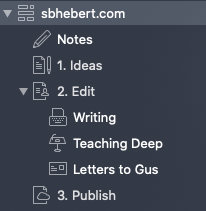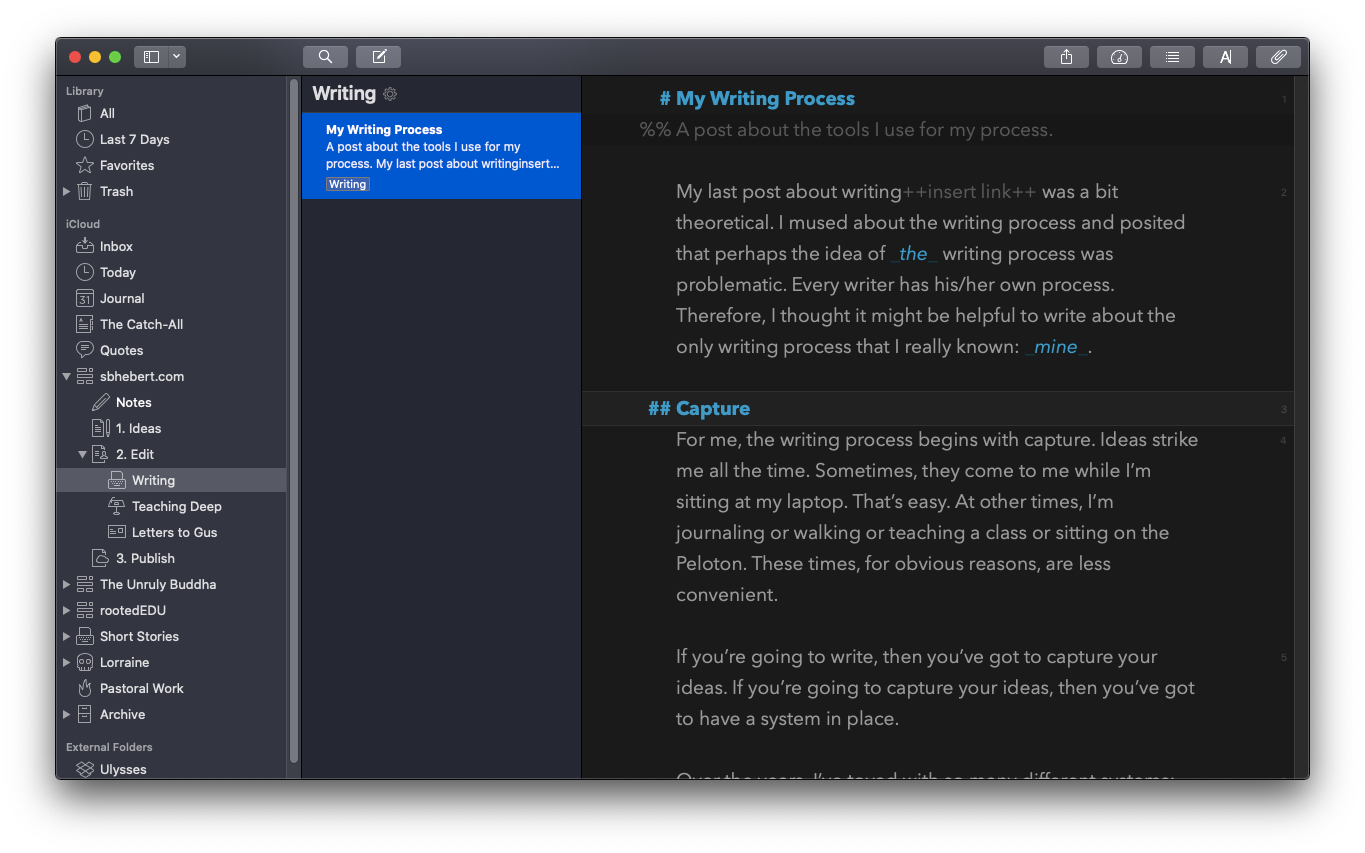My Writing Process
Every writer has his/her own process. Therefore, I thought it might be helpful to write about the only writing process that I really know: mine.

My last post about writing was a bit theoretical. I mused about the writing process and posited that perhaps the idea of the writing process was problematic. Every writer has his/her own process. Therefore, I thought it might be helpful to write about the only writing process that I really know: mine.
My process breaks down into these steps:
- Capture
- Process
- Rewrite
- Repeat
I'll treat each one of them in detail below.
Capture
For me, the writing process begins with capture. Ideas strike me all the time. Sometimes, they come to me while I’m sitting at my laptop. That’s easy. At other times, I’m journaling or walking or teaching a class or peadaling away on the Peloton. These times, for obvious reasons, are less convenient.
If you’re going to write, then you’ve got to capture your ideas. If you’re going to capture your ideas, then you’ve got to have a system in place to capture those ideas, even when it's not convenient.
Over the years, I’ve toyed with so many different systems: notebooks, notecards, apps and apps and apps. I’ve looked at social bookmarking sites from del.icio.us to Pocket. I’ve used Evernote, Day One, Bear, and just about any other journaling app that you can think of. I’ve also experimented with using social media and microblogs for capturing ideas: Twitter and tumblr, especially. (Woah! I'd forgotten that my old tumblr even existed.) But in recent days, I think I’ve hit on a system that works for me.
The system requires two simple tools:
- my notebook and pen,
- the Ulysses app installed on my iPhone and Mac.
I’ll go over both of these in detail below.
Morning Pages
I cannot stress enough how important Julia Cameron’s “morning pages” have been for me as a writer and as a human being. Every morning, as per The Artist’s Way, I wake up and put down three pages of whatever into my notebook. Sometimes, it’s amazingly coherent, great stuff. Sometimes, it’s just me writing the same few phrases over and over again. Sometimes, it’s stream-of-consciousness garble that will only be seen by the people who take care of my estate in the wake of my death.
I could spend (and will likely do so) a whole post writing about the joys, trials, tribulations, and heartache that comes from the habit of morning pages. But, for the purposes of this post, I just want to make the point that the act of writing first thing in the morning does two things for me.
First, I begin my day writing. My friend Nick told me many years ago, “Any day that I spend writing is a good day.” I totally agree with him. If writing is my passion (and it is), then starting my day with writing is bound to get me off on the right foot. It puts me in the right frame of mind and helps me to feel like whatever the day might bring has not been lost because, at the very least, I got to do some writing!
Second, morning pages often produces unexpected ideas. Sometimes, as I’m writing, something really interesting starts to emerge. It’s a first draft, of course. It’s raw. It doesn’t need to find publication, but it’s there. I can point to many short stories, blog posts, and book chapters that began as explorations in my morning pages.
Here’s the great news: if you begin your day writing out some ideas, then those ideas are captured. Excellent! Each of my morning pages entries is dated, so I can easily reference them anywhere by writing out a simple note: “Notes for this idea can be found in morning pages on 12 May 2020.” I can put this line in any set of notes, and I’ll know to go find that notebook, turn to that day, and the ideas will be there.
Great!
As the years have gone by, the notebooks have piled up. I buy Leuchtturm 1917s (medium with a dot grid, thank you!) for this purpose. It takes me 3–4 months to work through one. They come with lovely labels so I can label the notebooks (using my typewriter, of course).
Ideas captured!
Ulysses Capture and Organization
A few months ago, thanks in part to their educator pricing, I started working in Ulysses. I’ve tried all kinds of other writing software. Microsoft Word is just too damn much. Apple's Pages is too focused on the pretty. Mellel was great when I was writing long, academic papers that required multiple languages, but I don’t need that now. GoogleDocs is fine, but a bit clunky on mobile devices. (NOTE: Of those, I'll take GoogleDocs for general document creation any day! The easy of creating and sharing is the best. It's just not my favorite when it comes to the business of writing.)
Ulysses is exactly what I wanted for these reasons:
- It uses Markdown which I love (and wish all text editors would use).
- It keeps a searchable library of all of my stuff.
- It syncs seamlessly across any cloud storage system. For me, that’s iCloud and Dropbox.
- It gives me a distraction-free environment to write.
- It publishes seamlessly to my blogs (which run Ghost).
- The mobile apps are just as powerful as the macOS app.
Ulysses is great for me. I love it.
In addition to being a worthy writing tool, Ulysses is also a great capture tool. I can easily send things to Ulysses, creating new sheets and using the search functions within Ulysses to find the stuff I’m looking for. Any time I use the "share" menu on my iPhone or Mac, Ulysses is there. You can even use Apple's Shortcuts to automate document and sheet creation in Ulysses. (But that's fodder for another post.)
I could write (and probably will!) a whole article about why Ulysses is the right tool for me. For the time being, just trust me. It’s great!
In Ulysses, I can keep things organized. I use three main buckets for that. (NOTE: This is an adaptation of an idea I stole from Shawn Blanc over at The Sweet Setup. He took it from Jeff Goins. If you write a blog, the basic setup makes a great deal of sense. But, of course, you should definitely alter it for your particular needs and style. Take it; adapt it; give credit where it's due.)
Here's what the library structure for the sbhebert.com section of Ulysses looks like:

Each of these items is explained below.
Notes
I have a bucket called “Notes.” In this bucket, I just put stuff I want to save. Maybe I saw some great quote while I was reading. Grab it and put it in Notes. Maybe someone inspired me to think of something, grab it and put it in Notes. I'm not sure how I'm going to use it, but capturing it seems like a good idea.
Notes, for me, are just little bits of writing stuff, pre-ideas, thoughts that have no place and maybe not even a context: a turn of phrase, an image, an inkling. Something that isn’t quite an idea, but that I feel may be useful later on.
Ideas
In the Ideas bucket, I create a sheet for each possible post. Typically, when I capture an idea, it just has three things:
- A descriptive title
- A comment that gives the gist of where the piece is going or gives a reference to my notebook where the idea has been written out by hand.
- A keyword associated with it that helps me to sort it when I'm trying to decide what to write next. My primary keywords right now, based on what I've been publishing to sbhebert.com are #writing, #letterstogus, and #teachingdeep.
Later, as more comes to me, I might flesh the idea out with a structure or notes or whatever. The lovely thing about Ulysses is that I can easily find my ideas and add notes to them using either the commenting features or the metadata features.
Edit
When I start to write a pieces (as I’m doing now), I move it to the Edit bucket. In the edit bucket, I keep only pieces that are in draft mode. These sheets are headed toward publication. They are ideas that I’ve liked enough not only to develop, but also to write.
I’m pretty serious about what gets into the Edit section. I have to really like it. It has to be something that I’m willing to spend a couple of hours on, because each post on one of my blogs typically takes 3 to 4 hours of work to produce. For a sbhebert.com, I typically have no more than two or three pieces in my Edit bucket. For my other blogging projects, I usually only have one.
The advantage here is that I can open up that folder and see exactly what I’m working on at a quick glance. I don’t have to spend a bunch of time thinking about where I want to spend my time for this writing session. I just open up the Edit folder and get rolling.
Moreover, I'm using Ulysses's filter function to create groups based on the keywords above. When it's time to sit down and work on a writing post, I can just click on that "Writing" group and know that those are items that fall into that category. Grab one of those ideas and start writing!
Process
I believe deeply in Anne Lamott’s notion of the “shitty first draft.” If you haven’t read Lamott’s Bird by Bird, then hop over to the link I just provided you, order it up, and read over the course of the next weekend. Most importantly, as far as I’m concerned, pay attention to her chapter “Shitty First Draft” or “SFD” as I tend to call it.
The SFD is a draft that no one will ever see. It’s just you writing and whatever comes out is what comes out. It’s an exploration. You go wherever the idea takes you. Only at the end of that draft will you start to understand what you’re really writing about. That means that many of the words that you’ll produce will get cut, rearranged, rephrased, whatever. That’s fine.
Here's a picture of what this post looked like in Ulysses after that SFD:

In this case, much of the finished product is there, but much of it is not.
Writing, to be honest, is not an efficient process. We produce far more than we publish. We only publish the best of our work. Before we get there, we go through many ideas, many drafts. That’s okay. Writing is a rollercoaster and publication is the finish. While we experience relief when the coaster slides into the finish, it’s the big drops and the loops and the G’s that we’re gonna pull on our way around the track that we really look forward to.
Trust the process and know that you can always go to the next step: REWRITE.
Rewrite
The art of good writing is rewriting. Every piece that I publish goes through multiple versions. It begins in that idea bucket where I flesh out what I think it’s going to be about. Then I write the SFD. The SFD then gets rearranged, reworded, reworked until it makes sense as a complete whole.
Rewriting is where we taking something that was difficult to put on the page, and we make it look easy. Rewriting is where we achieve that effortless flow that we call “voice.”
Rewriting is also where the ordinary writer makes himself look like a genius. We can make things look like they were planned from the beginning. For example, in a good story or essay, we can go back and rewrite the beginning so that it matches the end, or we can beef up the middle so that it drops hints along the way that lead to that inevitable conclusion.
Rewriting is where we turn a mess of ideas into a full-fledged masterpiece.
Repeat
After rewriting, I publish. I put it out there and might pay some, but not too much, attention to the feedback. Mostly, though, I just release this feral little beast out into the wild and let the internet rip it apart. If you love something, you've got to set it free, I guess...
Once I’ve published it, I might do some promotion, but mostly I do what actually matters: I get to work on the next piece. I look at the notes that I’ve captured and the ideas that I’ve fleshed out. I decide which piece is ready to be edited and then I take it through its paces until it’s ready to go out there.
Rinse. Repeat.
That’s my writing process...today. Who knows? It could change next week...